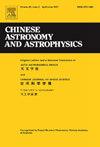金星磁尾中的大规模等离子体涡旋
Q4 Physics and Astronomy
引用次数: 0
摘要
利用金星快车上的空间等离子体和高能原子分析仪(ASPERA-4)的观测,先前的研究发现在金星磁尾中存在太阳风氢离子(H+)和金星电离层氧离子(O+)的大规模等离子体漩涡。当从尾部向行星方向观察时,漩涡是逆时针的。为了研究金星磁尾的等离子体特性,我们对Fedorov校准的ASPERA-4矩数据进行了统计分析。统计结果表明,在金星-太阳-轨道(VSO)和金星-太阳-电(VSE)坐标系中都存在太阳风H+和金星电离层O+的大尺度涡旋,但它们是顺时针的。考虑到逆时针和顺时针方向的等离子体涡旋都不能产生与观测到的金星磁尾磁场结构一致的磁场,且在与金星磁尾相似的火星磁尾中也没有观测到完整的等离子体涡旋,推断金星磁尾中可能不存在大规模的等离子体涡旋。未来需要更多的卫星观测来研究金星的等离子体特征。本文章由计算机程序翻译,如有差异,请以英文原文为准。
Large-scale Plasma Vortex in the Magnetotail of Venus
Using the observations by the Analyzer of Space Plasmas and Energetic Atoms on Venus (ASPERA-4) onboard Venus Express, Previous studies found a large-scale plasma vortice of solar wind hydrogen ions () and Venus ionospheric oxygen ions () in the magnetotail of Venus. The vortex is counterclockwise when viewed from the tail towards the planet. We conducted a statistical analysis of the ASPERA-4 moment data calibrated by Fedorov to investigate the plasma characteristics in Venusian magnetotail. The statistical results showed that there are large-scale vortices of the solar wind and Venus ionospheric in both the Venus-Solar-Orbital (VSO) and Venus-Solar-Electrical (VSE) coordinate systems, but they are clockwise. Considering that neither counterclockwise nor clockwise plasma vortices can generate a magnetic field consistent with the observed magnetic structure in the Venusian magnetotail, and no complete plasma vortex is observed in the Mars magnetotail with a magnetic structure similar to that of Venusian magnetotail, concluded that there may not be large-scale plasma vortices in the Venusian magnetotail, and that more satellite observations are needed in the future to investigate the plasma characteristics on Venus.
求助全文
通过发布文献求助,成功后即可免费获取论文全文。
去求助
来源期刊

Chinese Astronomy and Astrophysics
Physics and Astronomy-Astronomy and Astrophysics
CiteScore
0.70
自引率
0.00%
发文量
20
期刊介绍:
The vigorous growth of astronomical and astrophysical science in China led to an increase in papers on astrophysics which Acta Astronomica Sinica could no longer absorb. Translations of papers from two new journals the Chinese Journal of Space Science and Acta Astrophysica Sinica are added to the translation of Acta Astronomica Sinica to form the new journal Chinese Astronomy and Astrophysics. Chinese Astronomy and Astrophysics brings English translations of notable articles to astronomers and astrophysicists outside China.
 求助内容:
求助内容: 应助结果提醒方式:
应助结果提醒方式:


